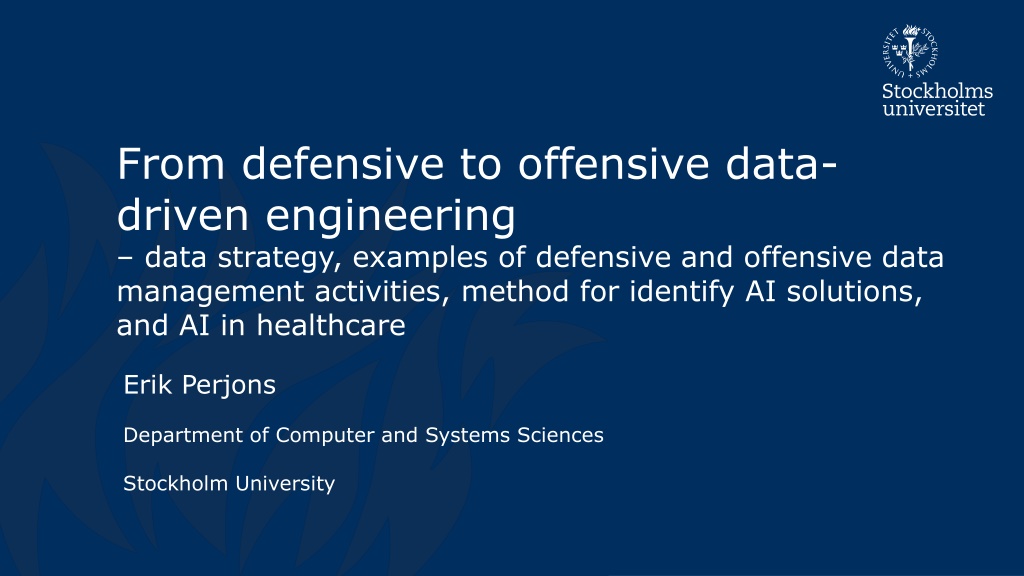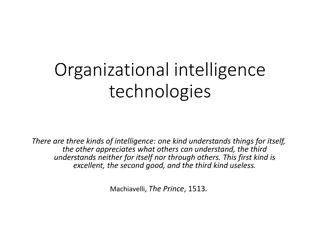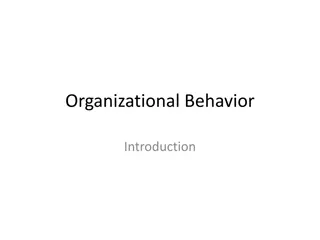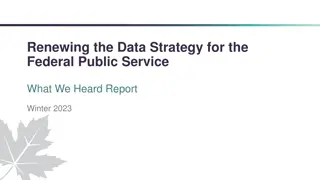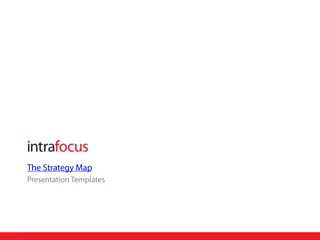Understanding Data Strategy for Organizational Success
A data strategy is a crucial plan for organizing, managing, and governing data assets within an organization. It involves clarifying goals, balancing offensive and defensive activities, and implementing various data management practices to ensure data security, compliance, integrity, and optimization for innovation and competitiveness. Organizations need a robust data strategy to drive decision-making, enhance performance, and achieve strategic objectives effectively.
Download Presentation

Please find below an Image/Link to download the presentation.
The content on the website is provided AS IS for your information and personal use only. It may not be sold, licensed, or shared on other websites without obtaining consent from the author. Download presentation by click this link. If you encounter any issues during the download, it is possible that the publisher has removed the file from their server.
E N D
Presentation Transcript
From defensive to offensive data- driven engineering data strategy, examples of defensive and offensive data management activities, method for identify AI solutions, and AI in healthcare Erik Perjons Department of Computer and Systems Sciences Stockholm University
Questions What is a data strategy? What should a data strategy include? Why do organisations need a data strategy?
What is a data strategy? A data strategy - is a plan to organize, manage and govern the data assets in an organization (DalleMule, L., & Davenport, T. H. (2017). What s your data strategy. Harvard Business Review, 95(3), 112-121.)
What is the core of the data strategy? The data strategy needs to: 1) clarify the goal of the data strategy for organizations 2) given the goal, provide data management activities (DalleMule, L., & Davenport, T. H. (2017). What s your data strategy. Harvard Business Review, 95(3), 112-121.)
What is the core of the data strategy? DalleMule & Davenport (2017) claim that an organization s data strategy should have a proper balance between offensive and defensive activities (DalleMule, L., & Davenport, T. H. (2017). What s your data strategy. Harvard Business Review, 95(3), 112-121.)
Defensive part of the data strategy Goals for the defensive part of the data strategy: Ensure data security, privacy, integrity, quality, regulatory compliance, and governance Data management defensive activities: Ensuring that data is in compliance with regulations Introduce data access control Detect and limit fraud and theft Ensure data integrity of data flows Provide a single source of truth (DalleMule, L., & Davenport, T. H. (2017). What s your data strategy. Harvard Business Review, 95(3), 112-121.)
Offensive part of the data strategy Goals for the offensive part of the data strategy: Improve innovation, the competitive position and increase profitability, revenue, and customer satisfaction Data management offensive activities: Generate customer insights by using data analysis, advanced data modelling and data science (including AI) work Integrate customer and market data for supporting decision making Include real time analysis (DalleMule, L., & Davenport, T. H. (2017). What s your data strategy. Harvard Business Review, 95(3), 112-121.)
The proper balance depends on a number of factors Market competition and dynamic External factors Regulatory environment (DalleMule, L., & Davenport, T. H. (2017). What s your data strategy. Harvard Business Review, 95(3), 112-121.)
External factors Hospitals operate in a highly regulated environments where data quality and protection are required Defensive activities Banks are heavily regulated but also operate on a dynamic market Retailers must react rapidly to competition and market changes Offensive activities (DalleMule, L., & Davenport, T. H. (2017). What s your data strategy. Harvard Business Review, 95(3), 112-121.)
The proper balance depends on a number of factors Market competition and dynamic External factors Regulatory environment The overall strategy of the organisation Maturity of data management Centralized or decentralized data management Internal factors Size of data budget (DalleMule, L., & Davenport, T. H. (2017). What s your data strategy. Harvard Business Review, 95(3), 112-121.)
Focusing on just defensive activities can inhibit flexibility There is a risk that organisation focus too much on defensive activities and data is not transformed into info that can be used by organizations strategically (DalleMule, L., & Davenport, T. H. (2017). What s your data strategy. Harvard Business Review, 95(3), 112-121.)
SSOT and MVOT The data strategy can include both defensive and offensive activitiesby introducing: a single source of truth (SSOT) and a multiple version of the truth (MVOT) Therefore, the framework could be seen as a SSOT-MVOT model (DalleMule, L., & Davenport, T. H. (2017). What s your data strategy. Harvard Business Review, 95(3), 112-121.)
Singe source of truth (SSOT) Singe source of truth (SSOT) - is a repository that contains one authorative copy of crucial data, such as customers, suppliers and product details (often called the master data) (DalleMule, L., & Davenport, T. H. (2017). What s your data strategy. Harvard Business Review, 95(3), 112-121.)
More about SSOT SSOT requires data governance activities to ensure that the data is accurate and timely so that data can be relied on for both defensive and offensive activities For example customers, suppliers and product details need to be specified in an agreed-upon way - supported by, for example a master data management system (DalleMule, L., & Davenport, T. H. (2017). What s your data strategy. Harvard Business Review, 95(3), 112-121.)
More about SSOT If a SSOT does not exist the company may not understand: what the relationships to customers and suppliers are what details are correct about its customers, suppliers and products SSOT is often implemented by introducing 1) a master data management system or 2) decide which systems are the master for different types of data (DalleMule, L., & Davenport, T. H. (2017). What s your data strategy. Harvard Business Review, 95(3), 112-121.)
Multiple versions of truth (MVOT) Multiple versions of truth (MVOT) provide different data for different business units MVOT is based on a SSOT but adapted to different units need. That is, SSOT data have to be transformed, enriched and adapted to be useful for the different needs for example, use different attributes for different concepts (DalleMule, L., & Davenport, T. H. (2017). What s your data strategy. Harvard Business Review, 95(3), 112-121.)
More about MVOT For example, the marketing and financial department are both interested in ad spending The marketing department is interested in the effectiveness of advertise product and services The financial department is interested cash flow, for example, when the invoices were payed That is, different departments are interested in different numbers, and therefore, their reports differs (DalleMule, L., & Davenport, T. H. (2017). What s your data strategy. Harvard Business Review, 95(3), 112-121.)
The need for MVOT According to DalleMule and Davenport (2017), the need for SSOT is well understood, but not the need for MVOT is not (DalleMule, L., & Davenport, T. H. (2017). What s your data strategy. Harvard Business Review, 95(3), 112-121.)
The need for MVOT Different business units have different needs Therefore, SSOT data need to be transformed, enriched and adapted for different business unit MVOT is the result such business-specific transformation However, MVOT must diverge from SSOT in a carefully controlled way otherwise siloed and uncontrolled MVOT will be created (DalleMule, L., & Davenport, T. H. (2017). What s your data strategy. Harvard Business Review, 95(3), 112-121.)
Centralized or a decentralized data management? If an organization should devolop a centralized or a decentralized data management depends on the organizations poisition on the offence-defence spectrum. Organisations with a defensive strategy usually prefer a centralized data management Organization with a offensive strategy has a more decentralised data management, where Unit Chief Data Officers have responsibility to MVOT and an Enterprise Chief Data Officer owns the SSOT (DalleMule, L., & Davenport, T. H. (2017). What s your data strategy. Harvard Business Review, 95(3), 112-121.)
The elements of data strategy Defensive Offensive Key objectives Ensure data security, privacy, integrity, quality, regulatory complience, and governance Improve innovation, competitive position and profitability Core activities Activities that optimize data quality, data extraction, standarization, storage, access Activities that optimize data analytics, modeling, visualization, transformation and enrichment Data management orientation Focus on control Focus on flexibility Enabling architecture Single source of truth (SSOT) Multiple sources of truth (MVOT) (DalleMule, L., & Davenport, T. H. (2017). What s your data strategy. Harvard Business Review, 95(3), 112-121.)
Data governance focusing on a defensive data strategy but is a good base for an offensive as well
Data governance Data governance aims to move data from an ungoverned state to a governed state, meaning: data shall be owned data shall be understood, inventoried and quality checked as well as corrected when data-related issues appear data shall be wisely used (Plotkin D. (2014) Data Stewardship, Morgan Kaufmann Publishers)
Governed data Governed data require: standardized business names standardized business definitions specified rules for data creation specifying what is needed for creating certain data specified rules for usage of the data specifying for which purpose the certain data can or cannot be used specified rules of data quality (in order to achieve and check such quality) documented physical location of the physical instances of the data specified data governors and data stewards responsible for the data (Plotkin D. (2014) Data Stewardship, Morgan Kaufmann Publishers)
Drivers for moving data to a governed state (Plotkin D. (2014) Data Stewardship, Morgan Kaufmann Publishers) Implementing information security Ungoverned data Ungoverned data Implementing master data management Improving data quality Governed data Ungoverned data Ungoverned data Implementing data warehousing and BI solutioms Developing new systems Ungoverned data
Questions How to identify new data-driven solutions, including AI, in an organization?
Method for identifying, architecting and developing data-driven solutions, including AI, in an organization
Method for identifying, architecting and developing data-driven solutions, including AI solutions The method is presented in Schmarzo (2013) and are developed for big data not explicitly for AI, but I have adapted it for AI as well Problem addressed by the adapted method: It is not clear for organizations how they can identify, architect and develop AI, big data - and other data-driven - solutions Therefore, there is a need of a solution engineering methodsupporting the organizations addressing this problem (adaption of Bill Schmarzo, Big Data. Understand How Data Powers Big Business, Wiley, 2013)
Method for identifying, architecting and developing data-driven solutions, including AI solutions 1. Understand what make the organization successful now, and in the future 5. Validate the feasibility of the AI enhanced initiative (and the including use cases) 3. Brainstorm how AI can support a business initiative or an opportunity in focus 6. Design och implement the solution 4. Break down the business initiative into use cases where AI is used and for each use case define requirements 2. Understand key business initiatives or opportunities (adaption of Bill Schmarzo, Big Data. Understand How Data Powers Big Business, Wiley, 2013)
Step 1: Understand the organisation Identify the most important strategic nouns and understand how they drive success, and envision how they, in the future, can drive further success Examples of important strategic nouns: the major products and services the revenue and cost drivers the key issues to address the key processes and activities the business stakeholders and their roles the major IT systems and their roles 1. Understand what make the organization successful now, and in the future (Schmarzo: Understand how the organisation makes money) Identify and understand key strategic nouns (adaption of Bill Schmarzo, Big Data. Understand How Data Powers Big Business, Wiley, 2013)
Step 2: Understand ongoing business initiatives 2. Understand key business initiatives or opportunities Identify and understand ongoing key initiatives or opportunities, based on step 1, but also based on: Reading business reports, such as annual reports Reading presentations by executives Interviewing key employees (Schmarzo: Understand your organisation s key business initiatives) (adaption of Bill Schmarzo, Big Data. Understand How Data Powers Big Business, Wiley, 2013)
Step 3: Brainstorm about AI impact Four ways that AI, big data and advanced analytics can impact a business initiative or an opportunity: Mining more detailed transaction data Integrate unstructured internal and external data - for more accurate and complete decision Improve real time delivery of data - for more timely decision Apply different forms of predictive analytics to uncover causalty hidden in the data for more actionable and predictive decision 3. Brainstorm how AI can impact a business initiative or an opportunity (Schmarzo: Brainstorm big data business impact) (adaption of Bill Schmarzo, Big Data. Understand How Data Powers Big Business, Wiley, 2013)
Step 4: Design use cases where AI is used 4. Break down the business initiative into use cases where AI is used and for each use case define requirements Design use cases where AI, big data and analytics could enhance a business initiative in focus, and specify the following for each use case: targeted stakeholders, including their roles and responsibilies business questions that the stakeholders try to answer business decisions that the stakeholders try to make requirements on data and data analysis algorithms/models as well as user experiences design key performance indicators (in order to make it possinle to measure the success of the use case) (Schmarzo: Break down the business initiative into use cases) (adaption of Bill Schmarzo, Big Data. Understand How Data Powers Big Business, Wiley, 2013)
Step 4: Design use cases where AI is used 4. Break down the business initiative into use cases where AI is used and for each use case define requirements Design use cases where AI, big data and analytics could enhance a business initiative in focus, and specify the following for each use case: targeted stakeholders, including their roles and responsibilies business questions that the stakeholders try to answer business decisions that the stakeholders try to make requirements on data and data analysis algorithms/models as well as user experiences design key performance indicators (in order to make it possinle to measure the success of the use case) (Schmarzo: Break down the business initiative into use cases) (adaption of Bill Schmarzo, Big Data. Understand How Data Powers Big Business, Wiley, 2013)
Step 5: Validate the AI enhanced initiative and included use cases Validate the feasibility of the AI enhanced initiative (and the including use cases) by deploy data and technology (like a prototype), and for the initiative: Carry out a ROI/cost-benefit analysis Perform a feasibiliy study: Make a plan to manage data manage source systems, transformations, cleaning of data, decide master data, etc Make a plan to test and fine tune analytical models Develop mockups and wireframes to help the stakeholders understand the solution and its role in the daily business processes 5. Validate the feasibility of the AI enhanced initiative - and the including use cases (Schmarzo: Prove out the use case) (adaption of Bill Schmarzo, Big Data. Understand How Data Powers Big Business, Wiley, 2013)
Step 6: Design and implement the solution Design, plan for and implement the solution in form of one or a set of use cases, including, for example: Capture and the store the data needed, including internal and external data, structured and unstructured data. Capture and the store additional data about customers, products and operations, for further data analysis. This data is mainly found outside the existing business processes. Implement real-time data access when required. Implement the AI solution 6. Design och implement the solution (Schmarzo: Design and implement the big data solutions) (adaption of Bill Schmarzo, Big Data. Understand How Data Powers Big Business, Wiley, 2013)
Why AI in healtcare? AI has the potential to transform healthcare since healtcare is producing a large amount of clinical and administrative data This large amount of data can be used for analysis Moreover, research studies have shown that AI can carry out many key healthcare activities better than, or as well as, humans, such as diagnosing diseases, for example by analyzing radiology images (Davenport, T., & Kalakota, R. (2019). The potential for artificial intelligence in healthcare. Future healthcare journal, 6(2), 94)
AI is sparsely implemented Today, AI solutions are sparsely implemented in practical healthcare Existing AI solutions are mainly supporting the individual functions in healthcare, like radiology and pathology image analysis (Davenport, T., & Kalakota, R. (2019). The potential for artificial intelligence in healthcare. Future healthcare journal, 6(2), 94)
Why is AI sparsely implemented? 1(2) According to Davenport and Kalakota (2019), two major reasons for AI being sparsely implemented in practical healthcare are: AI solutions are focusing on limited tasks and are rarely integrated into the clinical processes Moreover, AI is not implemented in electronic record systems (EHR). Therefore, AI is not part of the system that most healthcare personnel use for their day-to-day work (Davenport, T., & Kalakota, R. (2019). The potential for artificial intelligence in healthcare. Future healthcare journal, 6(2), 94)
Why is AI sparsely implemented? 2(2) Panch et al. (2014) add additional important reasons for AI being sparsely implemented in practical healthcare are: Healthcare systems are complex and fragmented, and will not easily change as a result of new technology Healthcare organisations lack the capacity to collect the necessary training data of sufficient quality - while also respecting ethical principles and legal constraints (Panch, T., Mattie, H., & Celi, L. A. (2019). The inconvenient truth about AI in healthcare. NPJ digital medicine, 2(1), 1-3.)
AI technologies in healthcare Note, according to Devenport and Kalakota (2019), AI is not one technology, but rather a collection of them. Examples pf AI technologies: Machine learning Natural language processing Rule based expert system Physical robots Robotic process automation (Davenport, T., & Kalakota, R. (2019). The potential for artificial intelligence in healthcare. Future healthcare journal, 6(2), 94)
Machine learning Traditional machine learning is the most common application in healthcare. This application is mostly using supervised learning, which requires a training datasets to be used to be able to do the work Supervised learning systems are supporting the making of diagnosis, and predicting what treatment protocols are likely to be successful for a patient, based on various patient attributes and the treatment context (Davenport, T., & Kalakota, R. (2019). The potential for artificial intelligence in healthcare. Future healthcare journal, 6(2), 94)
Neural network and deep learning A more complex form of supervised machine learning is the neural network. Neural network make use of a network of variables that associate inputs with outputs and create weights on these associations, in order to predict outcome A neural network can also have variables on many different so called hidden layers, called deep neural network or deep learning Deep learning has been very successful for identifying clinically relevant features in imaging data - beyond what can be perceived by the human eye Deep learning is also increasingly used for speech recognition in NLP, see next slide (Davenport, T., & Kalakota, R. (2019). The potential for artificial intelligence in healthcare. Future healthcare journal, 6(2), 94)
Natural language processing Natural language processing (NLP) aims to make sense of human language. NLP includes application such as speech recognition, text analysis, translation. In healthcare, NLP can, for example, be used for analyzing unstructured clinical notes and supporting the transformation from speech to text (Davenport, T., & Kalakota, R. (2019). The potential for artificial intelligence in healthcare. Future healthcare journal, 6(2), 94)
Rule based expert system 1(2) Rule based expert system - require human experts and knowledge engineers to construct a series of rules in a particular knowledge domain, which will be the base for the expert system Rule based expert systems in healthcare - are the base for many clinical decision support system Rule based expert systems - are also be part of many medical record systems (i.e. EHR systems), for example, they provide functionality to warn for drug-to-drug interactions, and support the physician of making diagnoses (Davenport, T., & Kalakota, R. (2019). The potential for artificial intelligence in healthcare. Future healthcare journal, 6(2), 94)
